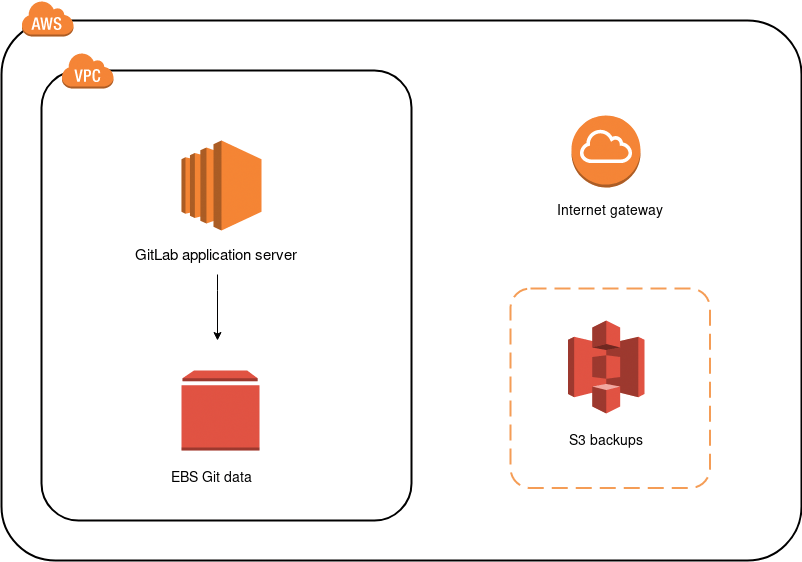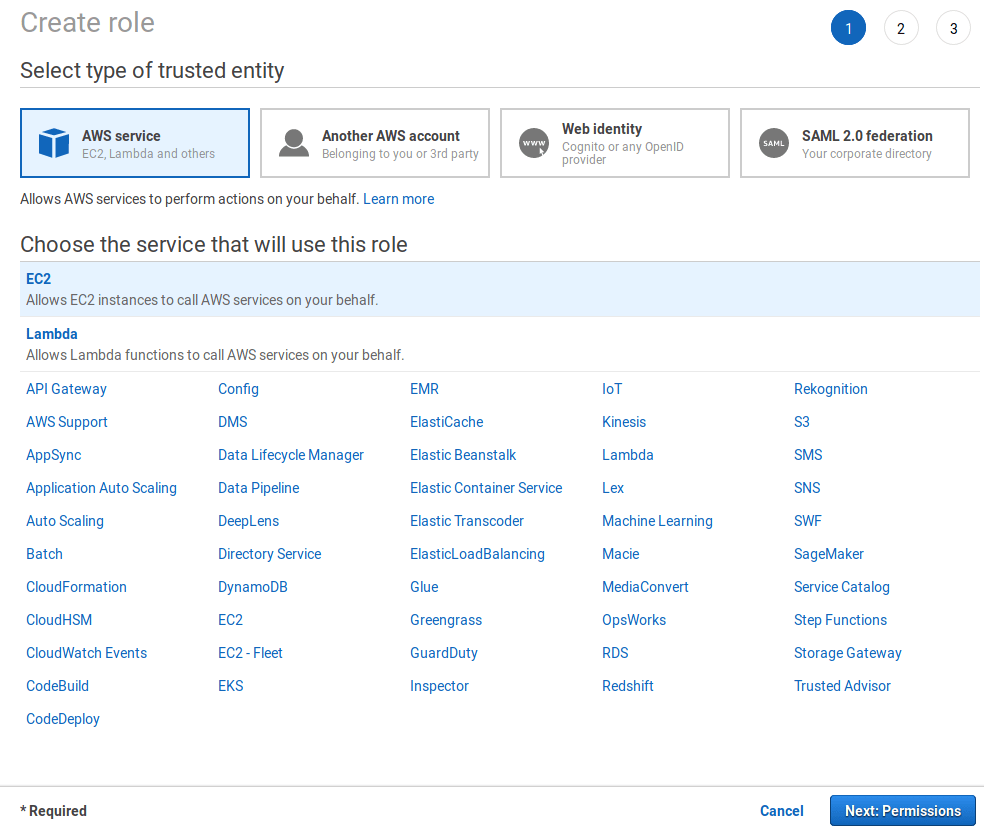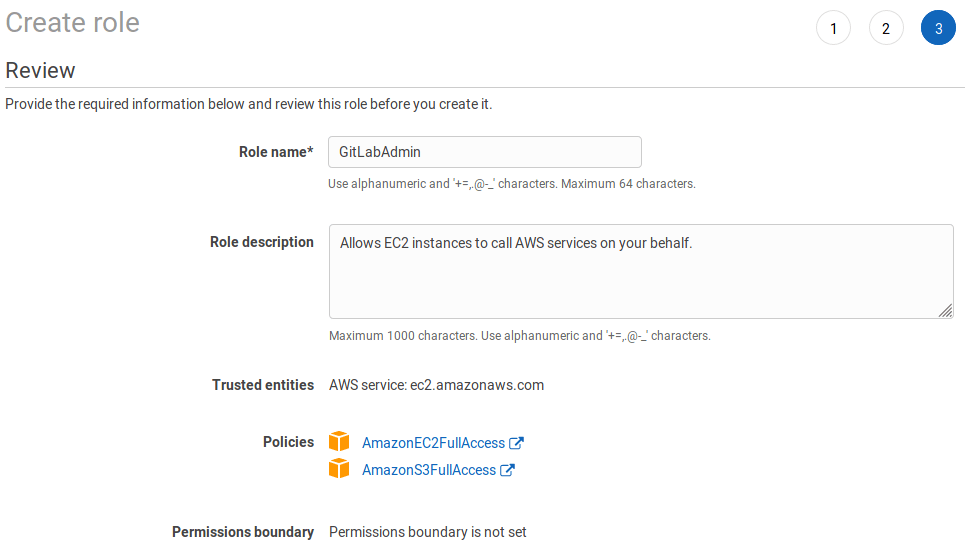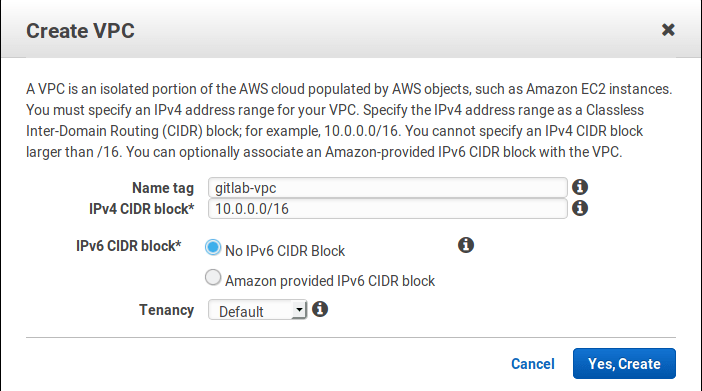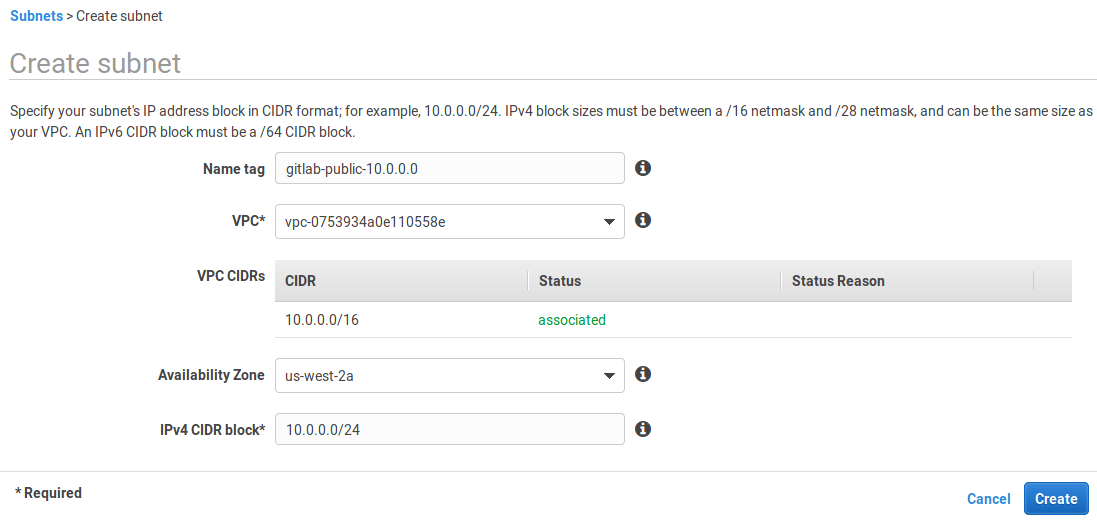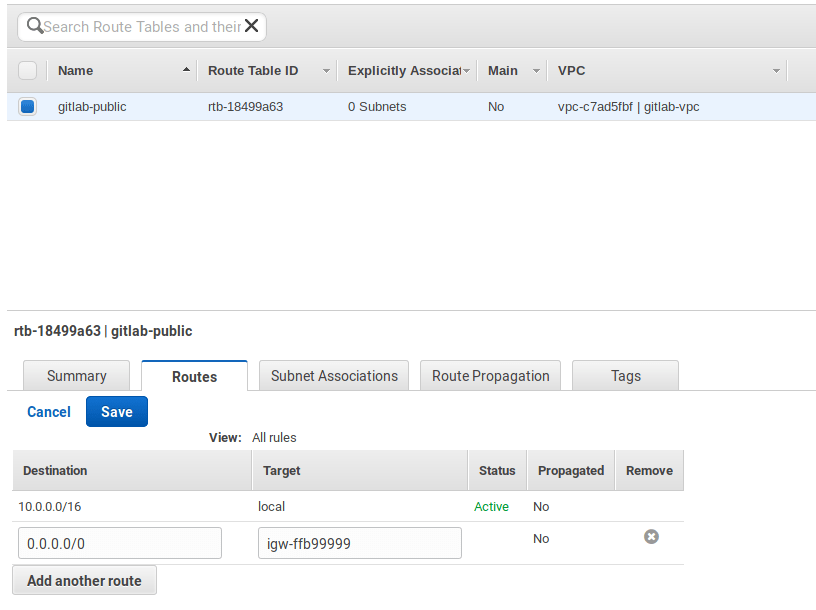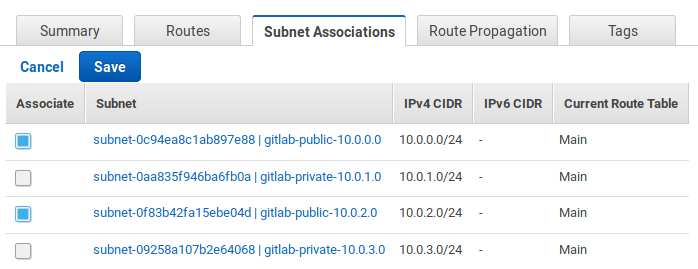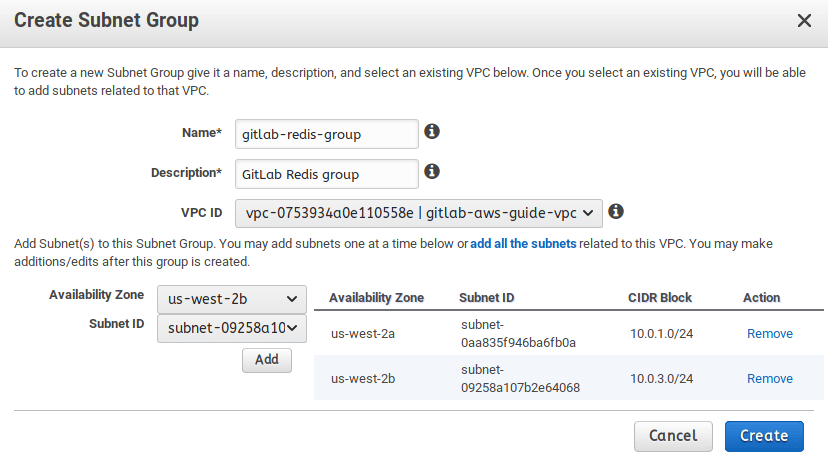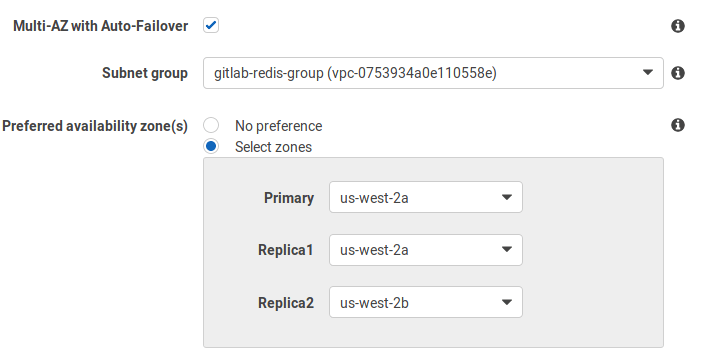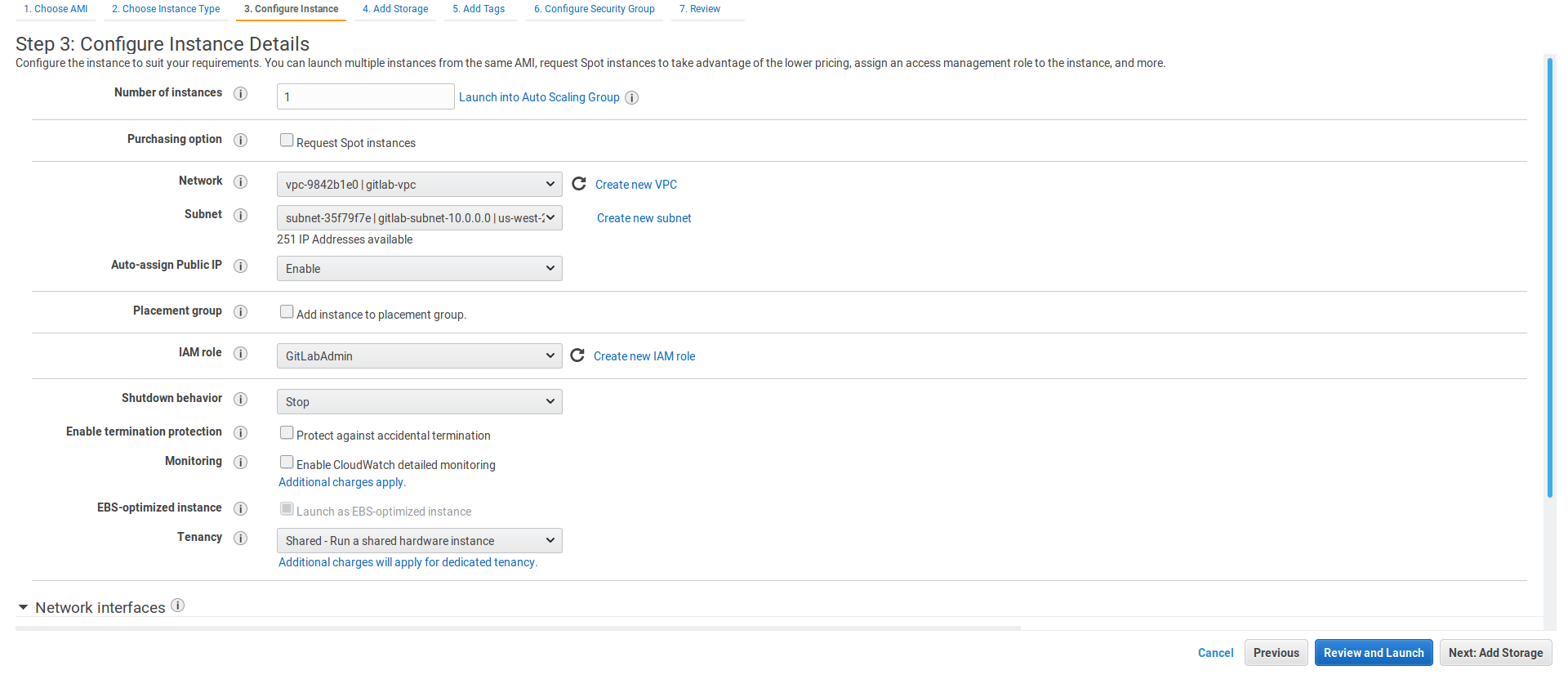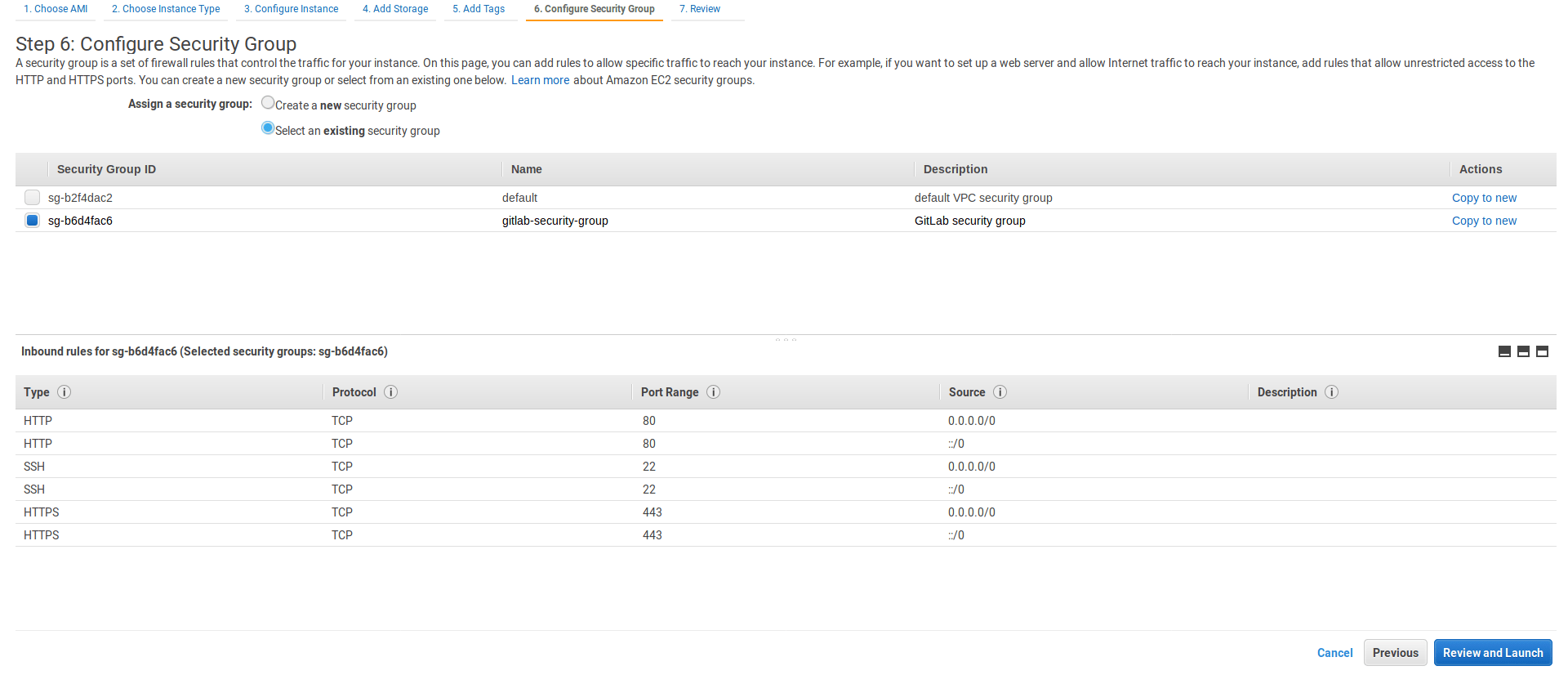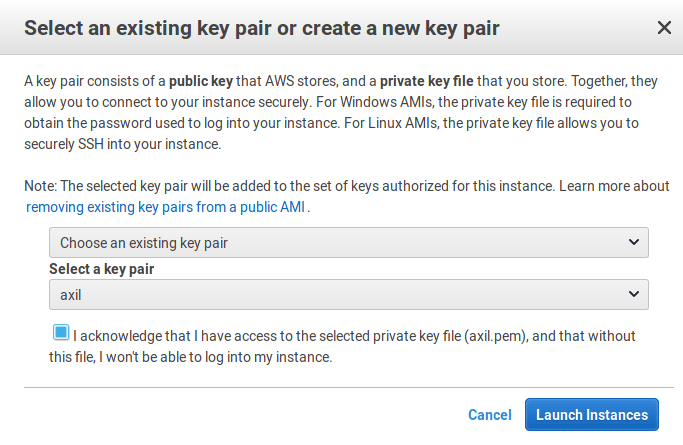24 KiB
Installing GitLab on AWS
GitLab can be installed on Amazon Web Services (AWS) by using the official AMIs provided with each release.
Introduction
GitLab on AWS can leverage many of the services that are already configurable with High Availability (HA). These services have a lot of flexibility and are able to adopt to most companies, best of all is the ability to automate both vertical and horizontal scaling.
In this guide we'll go through a basic HA setup where we'll start by configuring our Virtual Private Cloud and subnets to later integrate services such as RDS for our database server and ElastiCache as a Redis cluster to finally manage them within an auto scaling group with custom scaling policies.
Requirements
A basic familiarity with AWS and EC2 is assumed. In particular, you will need:
- An AWS account
- Create or upload an SSH key to connect to the instance via SSH
- A domain name under which GitLab will be reached
Architecture
Below is the diagram of the architecture.
Costs
Here's a list of the services we will use and their costs:
- EC2: GitLab will deployed on shared hardware which means on-demand pricing will apply. If you want to run it on a dedicated or reserved instance, consult the EC2 pricing page for more information on the cost.
- EBS: We will also use an EBS volume to store the Git data. See the Amazon EBS pricing.
- S3: We will use S3 to store backups, artifacts, LFS objects, etc. See the Amazon S3 pricing.
- ALB: An Application Load Balancer will be used to route requests to the GitLab instance. See the Amazon ELB pricing.
- RDS: An Amazon Relational Database Service using PostgreSQL will be used to provide database High Availability. See the Amazon RDS pricing.
- ElastiCache: An in-memory cache environment will be used to provide Redis High Availability. See the Amazon ElastiCache pricing.
Creating an IAM EC2 instance role and profile
To minimize the permissions of the user, we'll create a new IAM role with limited access:
-
Navigate to the IAM dashboard https://console.aws.amazon.com/iam/home and click on Create role.
-
Create a new role by choosing to AWS service > EC2. Once done, click on Next: Permissions.
-
Choose AmazonEC2FullAccess and AmazonS3FullAccess and click on Next: Review.
-
Give the role the name
GitLabAdminand click Create role.
Configuring the network
We'll start by creating a VPC for our GitLab cloud infrastructure, then we can create subnets to have public and private instances in at least two AZs. Public subnets will require a Route Table keep and an associated Internet Gateway.
VPC
Let's create a VPC:
-
Navigate to https://console.aws.amazon.com/vpc/home
-
Select Your VPCs from the left menu and then click on Create VPC. At the name tag enter
gitlab-vpcand at the IPv4 CIDR block enter10.0.0.0/16. If you don't require dedicated hardware, you can leave tenancy as default. Click Yes, Create when ready.
Subnets
Now, let's create some subnets in different Availability Zones. Make sure that each subnet is associated the the VPC we just created and that CIDR blocks don't overlap. This will also allow us to enable multi AZ for redundancy.
We will create private and public subnets to match load balancers and RDS instances as well:
-
Select Subnets from the left menu.
-
Click on Create subnet. Give it a descriptive name tag based on the IP, for example
gitlab-public-10.0.0.0, select the VPC we created previously, and at the IPv4 CIDR block let's give it a 24 subnet10.0.0.0/24: -
Follow the same steps to create all subnets:
Name tag Type Availability Zone CIDR block gitlab-public-10.0.0.0 public us-west-2a 10.0.0.0 gitlab-private-10.0.1.0 private us-west-2a 10.0.1.0 gitlab-public-10.0.2.0 public us-west-2b 10.0.2.0 gitlab-private-10.0.3.0 private us-west-2b 10.0.3.0
Route Table
Up to now all our subnets are private. We need to create a Route Table to associate an Internet Gateway. On the same VPC dashboard:
- Select Route Tables from the left menu.
- Click Create Route Table.
- At the "Name tag" enter
gitlab-publicand choosegitlab-vpcunder "VPC". - Hit Yes, Create.
Internet Gateway
Now, still on the same dashboard head over to Internet Gateways and create a new one:
-
Select Internet Gateways from the left menu.
-
Click on Create internet gateway, give it the name
gitlab-gatewayand click Create. -
Select it from the table, and then under the Actions dropdown choose "Attach to VPC".
-
Choose
gitlab-vpcfrom the list and hit Attach.
Configuring subnets
We now need to add a new target which will be our Internet Gateway and have it receive traffic from any destination.
-
Select Route Tables from the left menu and select the
gitlab-publicroute to show the options at the bottom. -
Select the Routes tab, hit Edit > Add another route and set
0.0.0.0/0as destination. In the target, select thegitlab-gatewaywe created previously. Hit Save once done.
Next, we must associate the public subnets to the route table:
Now that we're done with the network, let's create a security group.
Creating a security group
The security group is basically the firewall:
-
Select Security Groups from the left menu.
-
Click on Create Security Group and fill in the details. Give it a name, add a description, and choose the VPC we created previously
-
Select the security group from the list and at the the bottom select the Inbound Rules tab. You will need to open the SSH, HTTP, and HTTPS ports. Set the source to
0.0.0.0/0.TIP: Tip: Based on best practices, you should only allow SSH traffic from only a known host or CIDR block. In that case, change the SSH source to be custom and give it the IP you want to SSH from.
-
When done, click on Save.
PostgreSQL with RDS
For our database server we will use Amazon RDS which offers Multi AZ for redundancy. Let's start by creating a subnet group and then we'll create the actual RDS instance.
RDS Subnet Group
-
Navigate to the RDS dashboard and select Subnet Groups from the left menu.
-
Give it a name (
gitlab-rds-group), a description, and choose the VPC from the VPC dropdown. -
Click on "Add all the subnets related to this VPC" and remove the public ones, we only want the private subnets. In the end, you should see
10.0.1.0/24and10.0.3.0/24(as we defined them in the subnets section). Click Create when ready.
Creating the database
Now, it's time to create the database:
-
Select Instances from the left menu and click on Create database.
-
Select PostgreSQL and click Next.
-
Since this is a production server, let's choose "Production". Click Next.
-
Let's see the instance specifications:
- Leave the license model as is (
postgresql-license). - For the version, select the latest of the 9.6 series (check the database requirements) if there are any updates on this).
- For the size, let's select a
t2.mediuminstance. - Multi-AZ-deployment is recommended as redundancy, so choose "Create replica in different zone". Read more at High Availability (Multi-AZ).
- A Provisioned IOPS (SSD) storage type is best suited for HA (though you can choose a General Purpose (SSD) to reduce the costs). Read more about it at Storage for Amazon RDS.
- Leave the license model as is (
-
The rest of the settings on this page request a DB isntance identifier, username and a master password. We've chosen to use
gitlab-db-ha,gitlaband a very secure password respectively. Keep these in hand for later. -
Click on Next to proceed to the advanced settings.
-
Make sure to choose our gitlab VPC, our subnet group, set public accessibility to No, and to leave it to create a new security group. The only additional change which will be helpful is the database name for which we can use
gitlabhq_production. At the very bottom, there's an option to enable auto updates to minor versions. You may want to turn it off. -
When done, click Create database.
Now that the database is created, let's move on setting up Redis with ElasticCache.
Redis with ElastiCache
ElastiCache is an in-memory hosted caching solution. Redis maintains its own persistence and is used for certain types of the GitLab application.
To set up Redis:
-
Navigate to the ElastiCache dashboard from your AWS console.
-
Go to Subnet Groups in the left menu, and create a new subnet group. Make sure to select our VPC and its private subnets. Click Create when ready.
-
Select Redis on the left menu and click on Create to create a new Redis cluster. Depending on your load, you can choose whether to enable cluster mode or not. Even without cluster mode on, you still get the chance to deploy Redis in multi availability zones. In this guide, we chose not to enable it.
-
In the settings section:
- Give the cluster a name (
gitlab-redis) and a description. - For the version, select the latest of
3.2series (e.g.,3.2.10). - Select the node type and the number of replicas.
- Give the cluster a name (
-
In the advanced settings section:
-
In the security settings, edit the security groups and choose the
gitlab-security-groupwe had previously created. -
Leave the rest of the settings to their default values or edit to your liking.
-
When done, click Create.
Deploying GitLab
We'll use AWS's wizard to deploy GitLab and then SSH into the instance to configure the PostgreSQL and Redis connections.
Choose the AMI
-
On the EC2 dashboard click Launch Instance.
-
Choose the AMI by going to the Community AMIs and search for
GitLab EE <version>where<version>the latest version as seen in the releases page.
Choose instance type
Based on GitLab's requirements, the
instance type should be at least c4.xlarge. This is enough to accommodate 100 users:
Configure instance
-
Configure the instance. At "Network" choose
gitlab-vpcand one of the public subnets we created for that VPC. Select "Enable" for the "Auto-assign Public IP", and choose theGitLabAdminIAM role. -
Click Next: Add Storage.
Add storage
Edit the root volume to 20GB, and add a new EBS volume that will host the Git data. Its size depends on your needs and you can always migrate to a bigger volume later.
Add tags
To help you manage your instances, you can optionally assign your own metadata to each resource in the form of tags.
Let's add one with its key set to Name and value to GitLab.
Configure security group
-
Select the existing security group we have created.
-
Select Review and Launch.
Review and launch
Now is a good time to review all the previous settings. Click Launch and select the SSH key pair you have created previously.
Finally, click on Launch instances.
RDS and Redis Security Group
After the instance is being created we will navigate to our EC2 security
groups and add a small change for our EC2 instances to be able to
connect to RDS. First copy the security group name we just defined,
namely gitlab-ec2-security-group, and edit select the RDS security
group and edit the inbound rules. Choose the rule type to be PostgreSQL
and paste the name under source.
Similar to the above we'll jump to the gitlab-ec2-security-group group
and add a custom TCP rule for port 6379 accessible within itself.
Load Balancer
On the same dashboard look for Load Balancer on the left column and press the Create button. Choose a classic Load Balancer, our gitlab VPC, not internal and make sure its listening for HTTP and HTTPS on port 80.
Here is a tricky part though, when adding subnets we need to associate public subnets instead of the private ones where our instances will actually live.
On the security group section let's create a new one named
gitlab-loadbalancer-sec-group and allow both HTTP ad HTTPS traffic
from anywhere.
The Load Balancer Health will allow us to indicate where to ping and what makes up a healthy or unhealthy instance.
We won't add the instance on the next session because we'll destroy it momentarily as we'll be using the image we where creating. We will keep the Enable Cross-Zone and Enable Connection Draining active.
After we finish creating the Load Balancer we can re visit our Security Groups to improve access only through the ELB and any other requirement you might have.
Auto Scaling Group
Our AMI should be done by now so we can start working on our Auto Scaling Group.
This option is also available through the EC2 dashboard on the left
sidebar. Press on the create button. Select the new image on My AMIs and
give it a t2.medium size. To be able to use Elastic File System we need
to add a script to mount EFS automatically at launch. We'll do this at
the Advanced Details section where we have a User Data
text area that allows us to add a lot of custom configurations which
allows you to add a custom script for when launching an instance. Let's
add the following script to the User Data section:
#cloud-config
package_upgrade: true
packages:
- nfs-common
runcmd:
- mkdir -p /gitlab-data
- chown ec2-user:ec2-user /gitlab-data
- echo "$(curl --silent http://169.254.169.254/latest/meta-data/placement/availability-zone).file-system-id.aws-region.amazonaws.com:/ /gitlab-data nfs defaults,vers=4.1 0 0" >> /etc/fstab
- mount -a -t nfs
- sudo gitlab-ctl reconfigure
On the security group section we can choose our existing
gitlab-ec2-security-group group which has already been tested.
After this is launched we are able to start creating our Auto Scaling Group. Start by giving it a name and assigning it our VPC and private subnets. We also want to always start with two instances and if you scroll down to Advanced Details we can choose to receive traffic from ELBs. Lets enable that option and select our ELB. We also want to use the ELB's health check.
Policies
This is the really great part of Auto Scaling, we get to choose when AWS launches new instances and when it removes them. For this group we'll scale between 2 and 4 instances where one instance will be added if CPU utilization is greater than 60% and one instance is removed if it falls to less than 45%. Here are the complete policies:
You'll notice that after we save this AWS starts launching our two instances in different AZs and without a public IP which is exactly what we where aiming for.
After deployment
After a few minutes, the instance should be up and accessible via the internet. Let's connect to it and configure some things before logging in.
Configuring GitLab to connect with postgres and Redis
While connected to your server, let's connect to the RDS instance to verify access and to install a required extension:
sudo /opt/gitlab/embedded/bin/psql -U gitlab -h <rds-endpoint> -d gitlabhq_production
Edit the gitlab.rb file at /etc/gitlab/gitlab.rb
find the external_url 'http://gitlab.example.com' option and change it
to the domain you will be using or the public IP address of the current
instance to test the configuration.
For a more detailed description about configuring GitLab read Configuring GitLab for HA
Now look for the GitLab database settings and uncomment as necessary. In our current case we'll specify the adapter, encoding, host, db name, username, and password:
# Disable the built-in Postgres
postgresql['enable'] = false
# Fill in the connection details
gitlab_rails['db_adapter'] = "postgresql"
gitlab_rails['db_encoding'] = "unicode"
gitlab_rails['db_database'] = "gitlabhq_production"
gitlab_rails['db_username'] = "gitlab"
gitlab_rails['db_password'] = "mypassword"
gitlab_rails['db_host'] = "<rds-endpoint>"
Next we only need to configure the Redis section by adding the host and uncommenting the port:
# Disable the built-in Redis
redis['enable'] = false
# Fill in the connection details
gitlab_rails['redis_host'] = "<redis-endpoint>"
gitlab_rails['redis_port'] = 6379
The last configuration step is to change the default file locations to make the EFS integration easier to manage.
Finally run reconfigure, you might find it useful to run a check and a service status to make sure everything has been setup correctly.
sudo gitlab-ctl reconfigure
sudo gitlab-rake gitlab:check
sudo gitlab-ctl status
If everything looks good copy the Elastic IP over to your browser and test the instance manually.
Setting up the EBS volume
The EBS volume will host the Git data. We need to first format the /dev/xvdb
volume and then mount it:
-
First, create the directory that the volume will be mounted to:
sudo mkdir /gitlab-data -
Create a partition with a GUID Partition Table (GPT), mark it as primary, choose the
ext4file system, and use all its size:sudo parted --script /dev/xvdb mklabel gpt mkpart primary ext4 0% 100% -
Format to
ext4:sudo mkfs.ext4 -L Data /dev/xvdb1 -
Find its PARTUUID:
blkid /dev/xvdb1You need to copy the PARTUUID number (without the quotes) and use this to mount the newly created partition.
-
Open
/etc/fstabwith your editor, comment out the entry about/dev/xvdb, and add the new partition:PARTUUID=d4129b25-a3c9-4d2c-a090-2c234fee4d46 /gitlab-data ext4 defaults,nofail,x-systemd.requires=cloud-init.service,comment=cloudconfig 0 2 -
Mount the partition:
sudo mount -a
Now that the partition is created and mounted, it's time to tell GitLab to store
its data to the new /gitlab-data directory:
-
Edit
/etc/gitlab/gitlab.rbwith your editor and add the following:git_data_dirs({ "default" => { "path" => "/gitlab-data" } }) -
Save the file and reconfigure GitLab:
sudo gitlab-ctl reconfigure
Read more on storing Git data in an alternative directory.
Using S3 for the LFS objects, artifacts and Registry images
The S3 object storage can be used for various GitLab objects:
- How to store the LFS objects in S3 ((Omnibus GitLab installations))
- How to store Container Registry images to S3 (Omnibus GitLab installations)
- How to store GitLab CI job artifacts to S3 (Omnibus GitLab installations)
Setting up a domain name
After you SSH into the instance, configure the domain name:
-
Open
/etc/gitlab/gitlab.rbwith your favorite editor. -
Edit the
external_urlvalue:external_url 'http://example.com' -
Reconfigure GitLab:
sudo gitlab-ctl reconfigure
You should now be able to reach GitLab at the URL you defined. To use HTTPS (recommended), see the HTTPS documentation.
Logging in for the first time
If you followed the previous section, you should be now able to visit GitLab
in your browser. The very first time, you will be asked to set up a password
for the root user which has admin privileges on the GitLab instance.
After you set it up, login with username root and the newly created password.
Backup and restore
GitLab provides a tool to backup and restore its Git data, database, attachments, LFS objects, etc.
Some things to know:
- By default, the backup files are stored locally, but you can backup GitLab using S3.
- You can exclude specific directories form the backup.
- The backup/restore tool does not store some configuration files, like secrets, you'll need to do it yourself.
Backing up GitLab
To backup GitLab:
-
SSH into your instance.
-
Take a backup:
sudo gitlab-rake gitlab:backup:create
Restoring GitLab from a backup
To restore GitLab, first check the restore documentation and mainly the restore prerequisites. Then, follow the steps under the Omnibus installations section.
Updating GitLab
GitLab releases a new version every month on the 22nd. Whenever a new version is released, you can update your GitLab instance:
-
SSH into your instance
-
Take a backup:
sudo gitlab-rake gitlab:backup:create -
Update the repositories and install GitLab:
sudo apt update sudo apt install gitlab-ee
After a few minutes, the new version should be up and running.
Resources
- Omnibus GitLab - Everything you need to know about administering your GitLab instance.
- Upload a license - Activate all GitLab Enterprise Edition functionality with a license.
